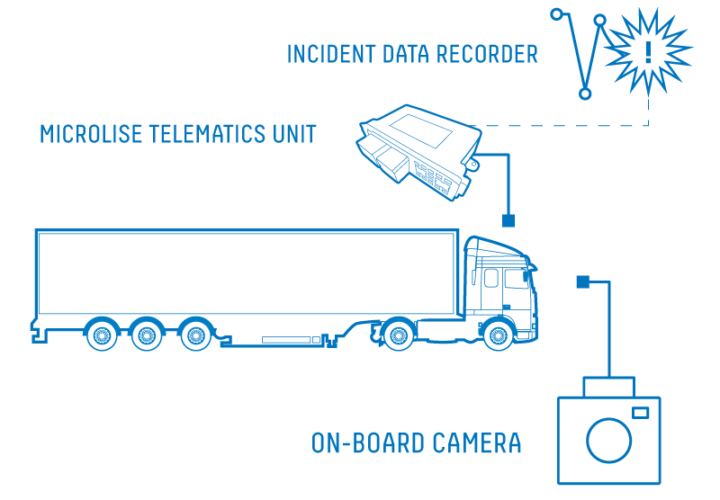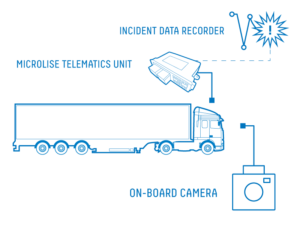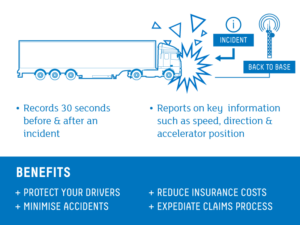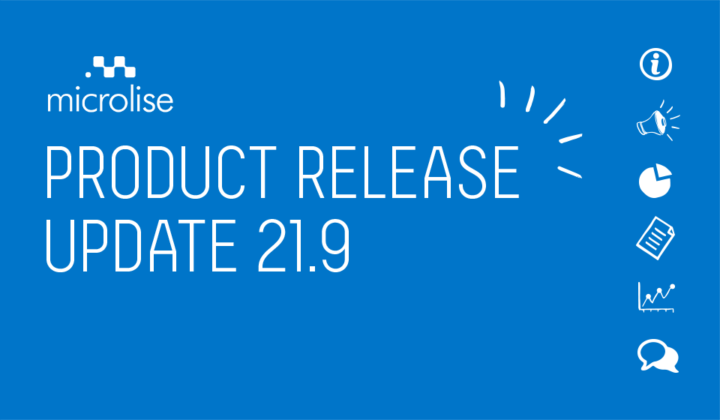With safety rightly becoming an ever more important topic for fleet operators, we’ve developed a set of tools to not only reduce the severity and number of accidents, but also reduce the cost impact when claims do have to be made. Claiming quickly and having all of the evidence to hand when a claim does need to be made is essential to making sure costs stay under control.
We have developed the Microlise Safety Module to address all of these issues. The option to deploy Forward Facing Cameras and an Incident Data Recorder enable a detailed insight into what was happening 30 seconds before and after an incident.
By monitoring the speed, direction, accelerator position, braking, ABS status, gears, cruise control and clutch; a complete overview of what happened immediately before and after an incident happened becomes available. Real-time feedback, through the Microlise Driver Feedback Module, of contextual speeding, harsh braking and cornering and rollover alert can also mitigate potentially dangerous driving behaviour as it unfolds and before anything has even occurred.
In terms of compliance, the Safety Module, in addition to the wider portfolio of Microlise solutions, plays a key role in supporting FORS accreditation. This is a topic we will cover on the blog in the future and a document on FORS and telematics is available for download.
Customers who have implemented the Safety Module have achieved reductions of over 90% in speeding and reduced incident levels by over 70%, leading to a significant reduction in claim costs and future renewals.
Operators have also seen fast return on investment. One Microlise customer without the Safety Module in place lost a vehicle for eighteen months while investigations were ongoing.
Incident analysis uses a black box recording function which links with the Microlise telematics solution. It records event information and is triggered by incidents such as harsh braking and rapid deceleration; or when the camera on-board is triggered.
The telematics unit records the various control functions of the vehicle and recorded data is packaged up and sent immediately through the mobile phone network to a safe storage area on the company server. The parameters are sampled four times a second for 30 seconds before and after an incident and sent along with the details of the vehicle, driver, date and time.
All of the information can then be quickly reviewed and, whether at fault or not, a fast resolution can be made.
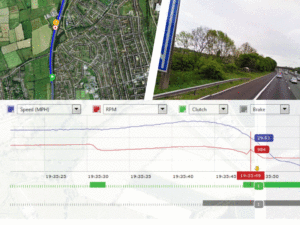
It doesn’t stop there. The Safety Module can significantly reduce the impact on a haulier’s business.
Reduced Accident Rates – As already discussed, telematics allows for very precise, pertinent and accurate data to be available when an accident does occur. Understanding driving performance through using this data allows drivers to be nurtured to reduce the likelihood of accidents happening in the first place.
Protect Drivers – Having accurate and detailed data on hand means it is harder for false claims to be made. The real facts will be available after any incident, meaning false claims can be identified early and appropriate action taken.
Expedite Claims Process – Following an accident, data can also be filed quickly with the authorities and insurance company. That’s time that could be more effectively spent on other tasks.
Reduce Insurance Costs – Given the extensive information available insurance premiums can be reduced in the long term.
Evidence of Near Miss Incidents – Drivers may not always report near miss situations for a range of reasons. The incident data recorder assists with the identification of drivers more at risk of accidents and helps identify potential accident blackspots.
The Trends behind the Needs
Safety on the roads is something that, as a nation, we have been taking more and more seriously as we’ve progressed through the 21st century. Government statistics show that this focus is having a real impact, with the number of fatalities halving since the start of the millennium.
HGV operators, haulage companies and fleet operators have also been giving safety the priority it deserves, with new technologies coming onto the market helping to make a difference. This is both in terms of reducing the cost of insurance premiums and claims, and lowering the number of incidents and therefore the human impact.
Figures published in Fleet News recently suggest that the number of companies now outsourcing their claims process is growing. One firm called FMG, specialising in incident management, has noted a 140% increase in demand for its in-house third party claims services over the last 18 months. According to FMG, telematics and in-vehicle camera technology can often support the fight against fraudulent claims.

